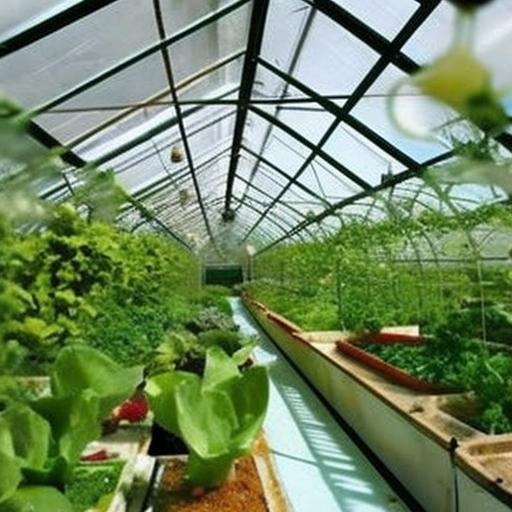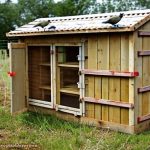Aquaponic greenhouses are a unique and innovative way to grow plants and raise fish in a symbiotic environment. In an aquaponic system, fish waste provides nutrients for the plants, while the plants filter the water for the fish. This creates a sustainable and efficient ecosystem where both plants and fish thrive.
On the other hand, chicken coops are structures designed to house chickens and provide them with a safe and comfortable environment. Chickens are not only great for producing eggs and meat, but they also provide natural pest control and their manure is an excellent fertilizer for plants.
Combining aquaponic greenhouses with chicken coops can have numerous benefits. The chickens can help regulate temperature and humidity in the greenhouse, provide natural pest control, and their manure can be used to fertilize the plants. This combination creates a sustainable and self-sufficient system where everything works together to create a thriving ecosystem.
Key Takeaways
- Keeping chickens in an aquaponic greenhouse can provide numerous benefits, including natural pest control, fertilizer production, and fresh eggs.
- Before starting a chicken coop in your aquaponic greenhouse, it’s important to research and understand the legal considerations in your area.
- Choosing the right chicken breed for your aquaponic greenhouse depends on factors such as egg production, temperament, and climate adaptability.
- When building a chicken coop in your aquaponic greenhouse, consider factors such as size, ventilation, and lighting to ensure the health and comfort of your chickens.
- Feeding your chickens in an aquaponic system requires a balance of commercial feed and natural food sources, such as insects and plants, to maintain a healthy ecosystem.
Benefits of Keeping Chickens in an Aquaponic Greenhouse
1. Chickens provide natural pest control: Chickens are excellent at controlling pests such as insects, slugs, and snails. They will happily eat any pests they come across, reducing the need for chemical pesticides in your greenhouse. This not only benefits your plants but also creates a healthier environment for you and your family.
2. Chicken manure is a great fertilizer for plants: Chicken manure is rich in nitrogen, phosphorus, and potassium, which are essential nutrients for plant growth. When chickens are kept in an aquaponic greenhouse, their manure can be directly used as fertilizer for the plants. This eliminates the need for synthetic fertilizers and reduces waste.
3. Chickens can help regulate temperature and humidity in the greenhouse: Chickens generate heat through their body heat and their activities. In colder months, this can help to keep the greenhouse warm. Additionally, chickens produce moisture through their respiration and droppings, which can help to increase humidity levels in the greenhouse. This is beneficial for plants that require higher humidity levels to thrive.
Legal Considerations: Can You Keep Chickens in Your Area?
Before you start keeping chickens in your aquaponic greenhouse, it is important to research and understand the local laws and regulations regarding chicken keeping. Some areas may have restrictions on the number of chickens you can keep, the type of coop you can have, or even prohibit chicken keeping altogether.
Start by checking your local zoning laws and regulations. These laws determine what activities are allowed in different areas, including whether or not you can keep chickens. You may need to obtain a permit or license to keep chickens, so it is important to familiarize yourself with the requirements and procedures.
If you live in a neighborhood with a homeowners’ association (HOA), you should also check their rules and regulations. Some HOAs have specific guidelines regarding chicken keeping, such as the size and appearance of the coop or the number of chickens allowed.
Choosing the Right Chicken Breed for Your Aquaponic Greenhouse
When choosing a chicken breed for your aquaponic greenhouse, there are several factors to consider:
1. Climate: Consider the climate in your area and choose a breed that is well-suited to it. Some breeds are better adapted to cold climates, while others thrive in hot climates.
2. Space: Consider the size of your greenhouse and choose a breed that will be comfortable in the available space. Some breeds are more active and require more space to roam, while others are more content in smaller areas.
3. Egg production: If you are primarily interested in egg production, choose a breed known for its high egg-laying capabilities. Some breeds can lay up to 300 eggs per year, while others may only lay around 100 eggs per year.
Recommended breeds for aquaponic systems include Rhode Island Reds, Sussex, and Australorps. These breeds are known for their hardiness, adaptability to different climates, and good egg-laying capabilities.
Building a Chicken Coop in Your Aquaponic Greenhouse: Things to Consider
Building a chicken coop in your aquaponic greenhouse requires careful planning and consideration. Here are some things to consider:
1. Materials needed for building a coop: Choose materials that are durable, weather-resistant, and easy to clean. Common materials used for chicken coops include wood, metal, and plastic. Make sure the materials you choose are safe for the chickens and will not leach harmful chemicals into the environment.
2. Placement of the coop within the greenhouse: Consider the layout of your greenhouse and choose a location for the coop that allows for easy access and maintenance. The coop should be placed in an area that receives adequate sunlight and ventilation.
3. Ensuring proper ventilation and lighting: Proper ventilation is essential to prevent the buildup of ammonia and other harmful gases in the coop. Install windows or vents to allow fresh air to circulate. Additionally, provide adequate lighting to ensure the chickens have enough light for their activities and egg production.
Designing Your Chicken Coop Plan: Size, Ventilation, and Lighting

When designing your chicken coop plan, there are several factors to consider:
1. Determining the appropriate size for your coop: The size of your coop will depend on the number of chickens you plan to keep and the available space in your greenhouse. As a general rule of thumb, each chicken should have at least 4 square feet of indoor space and 10 square feet of outdoor space.
2. Importance of proper ventilation and lighting: Proper ventilation is crucial to remove excess moisture, ammonia, and other gases from the coop. This helps to prevent respiratory issues in the chickens and maintain a healthy environment. Additionally, chickens require adequate lighting for their activities and egg production. Natural light is ideal, but if that is not possible, you can use artificial lighting.
3. Tips for designing a functional and comfortable coop: Consider adding features such as roosting bars, nesting boxes, and a dust bath area to provide the chickens with a comfortable and stimulating environment. Make sure the coop is easy to clean and maintain, with removable trays or flooring for easy waste removal.
Feeding Your Chickens in an Aquaponic System: What You Need to Know
Feeding your chickens in an aquaponic system requires some additional considerations:
1. Understanding the nutritional needs of chickens: Chickens require a balanced diet that includes protein, carbohydrates, fats, vitamins, and minerals. While they can get some nutrients from the fish waste in the aquaponic system, it is important to supplement their diet with additional feed to ensure they are getting all the necessary nutrients.
2. Incorporating fish waste into their diet: The fish waste in the aquaponic system can be a valuable source of nutrients for the chickens. You can collect the solid waste from the fish tank and feed it to the chickens as a protein-rich treat. This not only reduces waste but also provides additional nutrition for the chickens.
3. Supplementing with additional feed if necessary: Depending on the size of your aquaponic system and the number of chickens you have, you may need to supplement their diet with additional feed. Choose a high-quality chicken feed that is appropriate for their age and stage of development.
Maintaining Your Chicken Coop and Aquaponic System: Tips and Tricks
To ensure the health and well-being of your chickens and the success of your aquaponic system, regular maintenance is essential:
1. Regular cleaning and maintenance of the coop: Clean the coop regularly to remove waste and prevent the buildup of harmful bacteria. Replace bedding material as needed and disinfect the coop periodically to prevent the spread of diseases.
2. Monitoring water quality in the aquaponic system: Regularly test the water quality in your aquaponic system to ensure it is within the appropriate parameters for both the fish and the plants. Monitor pH levels, ammonia levels, and nitrate levels to maintain a healthy and balanced ecosystem.
3. Troubleshooting common issues: Be prepared to troubleshoot common issues that may arise in your aquaponic system or chicken coop. This could include addressing pest infestations, preventing disease outbreaks, or adjusting environmental conditions to optimize plant and fish growth.
Maximizing Your Aquaponic Greenhouse’s Potential with Chickens
Incorporating chickens into your overall greenhouse plan can maximize its potential in several ways:
1. Using chicken manure to fertilize plants: Chicken manure is a valuable source of nutrients for plants. By using the chicken manure as fertilizer in your aquaponic system, you can reduce the need for synthetic fertilizers and create a more sustainable and self-sufficient ecosystem.
2. Creating a sustainable ecosystem: The combination of aquaponics and chicken keeping creates a closed-loop system where waste from one component becomes a valuable resource for another. The fish waste provides nutrients for the plants, which in turn filter the water for the fish. The chickens contribute by providing pest control and their manure becomes fertilizer for the plants. This creates a sustainable and self-sufficient ecosystem where everything works together to support each other.
Enjoying the Benefits of Keeping Chickens in Your Aquaponic Greenhouse
Combining chickens with aquaponic greenhouses can have numerous benefits, including natural pest control, nutrient-rich fertilizer, and temperature regulation. Before starting, it is important to research and understand the local laws and regulations regarding chicken keeping. Choose the right breed for your greenhouse and design a functional and comfortable coop. Feed your chickens a balanced diet, incorporating fish waste from the aquaponic system. Regularly maintain and monitor both the coop and the aquaponic system to ensure their health and success. By maximizing the potential of your aquaponic greenhouse with chickens, you can create a sustainable and self-sufficient ecosystem that benefits both plants and animals.
If you’re interested in keeping chickens in an aquaponic greenhouse, you might also find this article on chicken coop design and maintenance helpful. It provides valuable insights on creating a comfortable and functional living space for your feathered friends. Check it out here for expert tips and advice.
FAQs
What is an aquaponic greenhouse?
An aquaponic greenhouse is a system that combines aquaculture (raising fish) and hydroponics (growing plants in water) in a closed-loop system. The fish waste provides nutrients for the plants, and the plants filter the water for the fish.
Can I keep chickens in an aquaponic greenhouse?
Yes, you can keep chickens in an aquaponic greenhouse. However, it is important to consider the size of the greenhouse and the number of chickens you plan to keep. Chickens can provide additional nutrients for the plants and help control pests, but they also require space and proper care.
What are the benefits of keeping chickens in an aquaponic greenhouse?
Keeping chickens in an aquaponic greenhouse can provide several benefits, including a source of fresh eggs and meat, additional nutrients for the plants, and pest control. Chickens can also help maintain a healthy balance in the ecosystem of the greenhouse.
What are the challenges of keeping chickens in an aquaponic greenhouse?
Some of the challenges of keeping chickens in an aquaponic greenhouse include providing enough space for the chickens, managing their waste, and ensuring proper ventilation. Chickens can also be susceptible to diseases and pests, which can affect the health of the plants and fish in the system.
What should I consider before keeping chickens in an aquaponic greenhouse?
Before keeping chickens in an aquaponic greenhouse, it is important to consider the size of the greenhouse, the number of chickens you plan to keep, and the amount of care they will require. You should also research the specific needs of the breed of chicken you plan to keep and ensure that they are compatible with the other organisms in the system.
Meet Walter, the feathered-friend fanatic of Florida! Nestled in the sunshine state, Walter struts through life with his feathered companions, clucking his way to happiness. With a coop that’s fancier than a five-star hotel, he’s the Don Juan of the chicken world. When he’s not teaching his hens to do the cha-cha, you’ll find him in a heated debate with his prized rooster, Sir Clucks-a-Lot. Walter’s poultry passion is no yolk; he’s the sunny-side-up guy you never knew you needed in your flock of friends!







